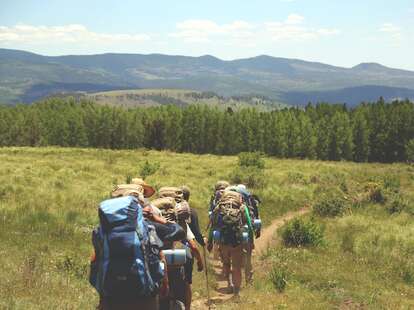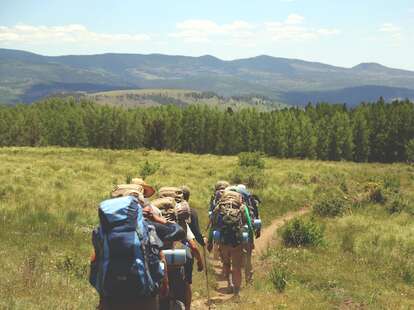
It is no secret that the great outdoors can do wonders for our mental health. And in 2021, we are more ready than ever to get out of the house and into the wild. Even newbies to hiking might want to opt for nature-focused getaways — from day hikes to glamping weekends and even longer backcountry backpacking trips. But for LGBTQIA+ folks, hiking isn’t always a simple and safe excursion. In fact, in 29 states, there are still no laws protecting people from discrimination based on sexual orientation or gender identity. This can turn what should be a fun escape into an anxiety-inducing venture. But with the inside scoop on hooking up with queer hiking groups (plus our picks for where to go), your trip can be a total win.
The Venture Out Project
The Venture Out Project (TVOP) is a non-profit organization that offers wilderness trips for LGBTQIA+ folks. Adventures include day hikes, an LGBTQ+Family Campout, forest bathing retreats, queer hiking and canoe trips, youth-centered as well as women-centered camping trips, POC hikes, and more. Wildly popular with those ages 25-35, they recently started a country-wide volunteer program, so keep an eye on Instagram and join in the fun when they visit your area.
QPOC Hikers
QPOC Hikers was founded by Jasmine Maisonet, a queer, non-binary person of color who developed a love for hiking while completing the 52 Hike Challenge. Born and raised in New York City, they created a welcoming outdoor community for queer people of color in the Pacific Northwest, where they now live. At the moment, there is typically one group hike each month and they have an annual overnight backpacking trip to Barclay Lake in Washington. Sign up for trips on their Facebook page and keep an eye on their Instagram to find out about upcoming trips.
Out There Adventures
Non-profit educational organization Out There Adventures was founded in Seattle by Elyse Rylander, who has a passion for LGBTQIA+ youth trips and is committed to empowering queer youth through connection with the natural world. Outdoor adventures include kayaking, climbing, and multi-day hiking trips and attendees travel from all over the country to participate in their programs (located in Oregon and Washington), so you’re sure to make some new friends on the trail.
Unlikely Hikers
Founded by Jenny Bruso, a queer hiker from Oregon, Unlikely Hikers aims to make their hikes as inclusive as possible: gay, transgender, disabled, non-binary, people of color, indigenous — everyone is welcome to join. There are now chapters of Unlikely Hikers across the US so the best way to find out about upcoming hikes in your area is by visiting their site and signing up for their mailing list. Also, don’t miss Bruso’s podcast, where she talks to other hikers about life on the trails. It’s the perfect thing to listen to when you head out alone but want some fun company.
Meetup
Many cities in the US have queer hiking groups, but Meetup.com lists more gay and lesbian hiking groups than any other platform. If you’re heading out in a major city, you’ll have the most choices with lots of new friends to be made. In New York City, try hooking up with LGBTQIA hikers, Backpacking Gay Men of NYC, and the Gay Men’s Over 40 Hiking Group. In Los Angeles, there’s Gay and Lesbian Sierrans (part of the Sierra Club). In Chicago, you’ll want to meet the Chicagoland Active Lesbian Meetup. In Austin, look for the Queer Adventurers of Austin. Finally, in Washington, DC, there’s Queer Hikers and in the San Francisco Bay Area, another chapter of the Rainbow Sierrans.
Facebook Groups
Another go-to resource for queer hiking groups in your area is Facebook. The trick to finding what you want is to make sure you select the “groups” option when searching for queer hiking. Local groups will be shown first and they also post group hike events.
The Wilderness Society x Pride Outside map
In order to help queer nature enthusiasts connect with each other, the Wilderness Society and Pride Outside have teamed up to create an interactive map that’ll show you dozens of LGBTQIA+ outdoors groups in one handy place. Also, if you host an LGBTQIA+ outdoor group and don’t see it listed on the map, you can add it and literally get your group “on the map.”
NOW, ABOUT WHERE TO GO…
The Olympic Peninsula
The Olympic Peninsula is a fantastic hiking destination in the Pacific Northwest, offering more than 600 miles of epic trails in Washington’s Olympic National Park that span various ecosystems: rainforests, Alpine tundra, wildflower meadows, snow-capped mountains, and rugged coastline. There’s also notable wildlife in the park to keep you on your toes on the trails like black-tailed deer, mountain goats, black bears, and cougars.
If you don’t know where to start, hit up some of the most popular hikes, which include any of the hikes in Hoh Rainforest; the Hurricane Ridge Trail and the Sunrise Ridge via the Sunrise Point Trail (both offer splendid views over the Hurricane Ridge and can be done in the same day); Rialto Beach to Hole-in-the-Wall; the Ozette Triangle (also known as the Cape Alava Loop) from Lake Ozette to the coast; and for more experienced hikers, the 10.5-mile Spruce Railroad Trail around Lake Crescent.
The 134-mile-long Olympic Discovery Trail, currently being established between Port Townsend and La Push on the Pacific Coast, will make for an incredible backcountry backpacking trip for experienced hikers once complete. At the moment, around 80 miles of the trail are finished, but if that’s too long a trek for you, you can conquer shorter segments of it for a day hike.
Great Smoky Mountains National Park
If you’re looking for a hiking haven on the East Coast, the Great Smoky Mountains, which are shared by Tennessee and North Carolina, might just be your next perfect adventure. With 150 trails inside Great Smoky Mountains National Park, it’s one of the very few national parks that does’t charge an admission fee. The lush forests offer 800 miles of trails with breathtaking vistas, cascading waterfalls, and diverse plant life. The best places to base yourself are in the towns of Gatlinburg, Pigeon Forge (home of Dollywood, Dolly Parton’s themed park), or Sevierville — all stunning places that you won’t hate to call (temporary) home.
If you’re one of those people who’s always dreamed of hiking the The Appalachian Trail, the 2,200-mile long trail from Georgia to Maine, this is your big chance. With 71 miles of the AP running through the Smoky Mountains, it takes about seven days to do the entire section of the thru-hike — a commitment we think is entirely worth it.
Sedona
The small artsy town of Sedona in northern Arizona is one of the most scenic destinations in the Southwest and makes a colorful base for your hiking vacation. Considered a sacred place by Native Americans, Sedona is made up of extraordinary red rock formations, buttes, and canyons. But in addition to its picturesque scenery, Sedona is also famous for its energy vortexes (aka, healing and spiritual energy). It draws in those seeking a place to connect with both nature and themselves.
There are over 100 trails in Sedona, some of which come with ancient Native American cave paintings, like the Palatki Ruins. The Hike House (on Highway 179 just south of the roundabout with the Open Gate Sculpture) is a must-visit for any last-minute hiking gear and its Energy Cafe, where you can fill up on good grub or kick off your boots and hang with other hikers on the patio. Hikes you should add to your must-do list include the Cathedral Rock Trail (the most famous trail in Sedona), the Devil’s Bridge Trail, the Airport Mesa Loop, the Bell Rock Pathway, and Boynton Canyon.
While you’re there, consider hitting up the Grand Canyon, which is only a short drive from Sedona. You can reach the South Rim in just over two hours and the East Rim in 2 hours and 45 minutes. Ideally, you’ll want to stay overnight to hike one of the Grand Canyon’s many trails.
Montana
Montana may be best known by foodies for elk and bison burgers, but hikers know it for its mesmerizing Glacier National Park. With 700 stunning lakes, glaciers, waterfalls, and 734 miles of trails, there are tons of top-rated hikes to choose from: Highline Trail (considered one of the best hikes in the US), Hidden Lake Overlook Trail, the Cracker Lake Trail, and Lake Josephine Trail. But there’s more to the state than just Glacier. Montana boasts changing landscapes, from the snowy peaks of the Rocky Mountains to the wide-open spaces of the Great Plains, and is a true hiker’s paradise. You’ll find trails throughout the state, including day hikes as well as multi-day backpacking trips in the vast Bob Marshall Wilderness, a designated wilderness area in Western Montana that spans both sides of the Continental Divide.
Montana is also home to the longest section of the 3,100-mile long Continental Divide National Scenic Trail (CDT), which is considered the most challenging of the three long-distance hikes in the US (the other two being the Appalachian Trail and the Pacific Crest Trail). If you don’t have the time (eight to 10 weeks) or the will to hike the entire 820 miles of the CDT in Montana, you can still tackle part of it. For example, the 110 miles that run inside Glacier National Park —or any part of that — will be an accomplishment that makes you proud.
Colorado
With over 39,000 miles of hiking trails, Colorado takes the crown of hiking destinations in the US. In addition to the Rocky Mountains, the Centennial State will wow you with orange-red rock formations, canyons, hot springs, waterfalls, alpine lakes, and flat tundra. Rocky Mountain National Park in northern Colorado, a UNESCO World Biosphere Reserve with over 100 peaks above 11,000 feet in altitude and 350 miles of trails, is one of the most popular parks in the country and can’t be missed. The scenic mountain town of Estes Park is only 90 minutes from Denver and surrounded by rugged peaks and scenic trails. It makes a great base for your longer adventures.
If you prefer shorter day hikes, settle in the mountain towns of Aspen or Breckenridge, and you’ll find plenty of trails nearby. Boulder, the super cool city at the base of the Rocky Mountains, has a lot of reasons to be loved — and is another popular base for day hikes, offering tons of hiking paths, some of which even start right in town.
If you want to challenge yourself to a mega-hike, check out the Colorado Trail, a 485-mile long-distance trail from Denver to Durango which takes between four and six weeks to finish. If that’s too long, you can hike shorter segments of the trail and still get all the awesomeness. Another popular challenge for experienced hikers is summiting one of the 58 “Fourteeners” — mountains taller than 14,000 feet — of which Colorado has more of than any other state.








